What an odd concept, to separate enjoyment of gardens from the process of garden-making. A garden magazine article a couple months ago introduced me to this astonishing notion, when it profiled the owner of a complex garden who spoke intelligently about his garden, knew every inch of it, but had it all designed, constructed, planted, and maintained by someone else. Shocking. Yes, all these years, and that particular idea had never occurred to me. What a revelation. And then a book is published this spring by an Englishwoman living in Wales, Anne Wareham, entitled “The Bad-Tempered Gardener,” in which she declaims “I hate gardening.” Hates it, yet spends a good part of her adult life imprinting the landscape with patterns such as this:
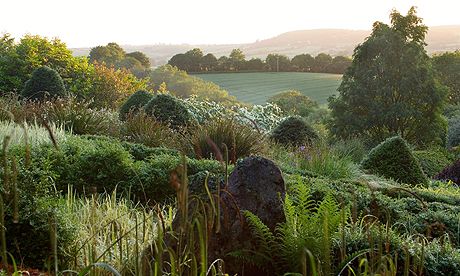
Photograph by Clive Nichols
Finally, a garden book I had to read.
After I began the book, Janine Robinson of Laguna Dirt loaned me the documentary Women in the Dirt, on California landscape architects. Both Wareham’s book and this documentary dredged up for me the continuing problem with discussing gardens, and that is the paucity of language at hand to describe intentions.
The work of one of the landscape architects profiled in the documentary, Andrea Cochrane.
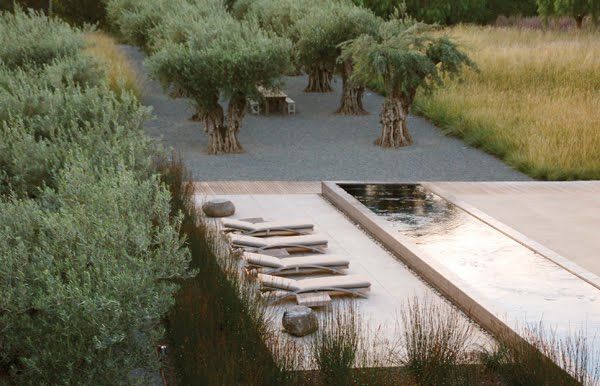
In the general garden media, vocabulary and scale of intent are at odds, terms are imprecise and often meaningless. Fundamentally, to make a garden is to sculpt the land, but there are vast differences in degrees of intention. We call a collection of pots on a balcony a garden and use the same word to describe Andrea Cochrane’s monumental work. I get the distinct impression from her book that Ms. Wareham’s approach is that of a landscape architect. (After visiting Beth Chatto’s plant-rich garden and meandering paths, Ms. Wareham’s response: “I realized…that I wanted strong shapes and pattern, straight lines, squares and circles — because they satisfy and please me.”) And in writing that, I know I’m dangerously straying into facile distinctions, including the age-old false choice of pitting design against growing plants for plants’ sakes. But for all the myriad reasons we choose to make a garden, if we invite and welcome criticism, as Ms. Wareham is doing, all that matters is the result at that moment in time when someone else views our efforts, not how many species of plants have been included or excluded.
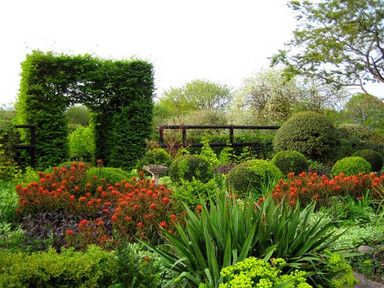
Photograph © Veddw House
Now that Veddw is relatively mature, her writing expresses a feeling of being its prisoner, consigned to the tedium of maintaining its hedges and overall shape, tasks she apparently loathes. Someone needs to take over the maintenance of Veddw so this talented landscape artist can take on fresh challenges. A practical but glib suggestion, because her rootedness to Veddw rings out from every page of her book.
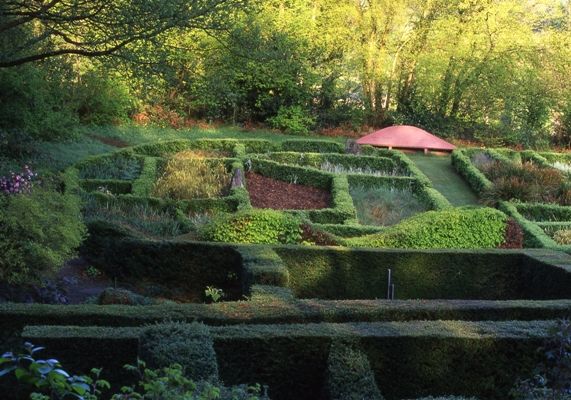
Grasses Parterre, Veddw copyright Charles Hawes
And like many landscape architects, Ms. Wareham deplores the plant collector mania that she feels ruins the design of so many gardens, the fixation on plants, their names, the “What is it?” nature of garden tours. She sets just a few rampageous species loose at Veddw to infill the grid of hedges, boundaries which she employs not only for structure but in some cases as historical allusion to the hard-scrabble agricultural life practiced by previous inhabitants on the fields of Veddw, deploying ornamental grasses as stand-ins for “crops.” Boisterous plants like fireweed, aka the Great Willowherb, Epilobium angustifolium, ribbon grass/Phalaris arundinacea, goutweed/Aegopodium are some of the plants she favors. Restraint in plant selection is her hallmark, and yet she says she’d like to pare it down even further, an approach bound to disappoint a garden-visiting public that craves plant diversity and the latest in cultivars. Image found here.
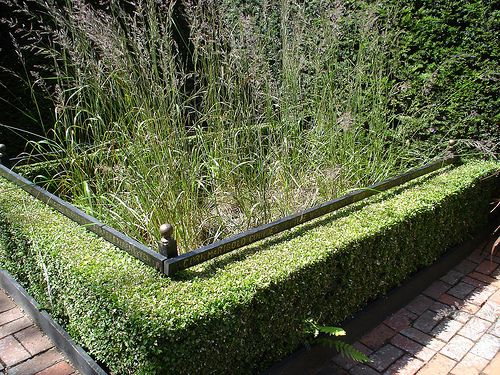
For me, the truest test of a book’s worth is if I find myself arguing with its author. On 7/28/11 Amy Stewart of Garden Rant reviewed this book, and the boisterous comments to her review prompted me to search for this draft post I had written but never posted on the blog. I’ve been arguing quite a bit with Ms. Wareham since reading her book. Like her garden, Ms. Wareham challenges and probes and asks: Why must it be so? It’s a voice out of The Confessions of Jean-Jacques Rousseau: “I have resolved on an enterprise which has no precedent, and which, once complete, will have no imitator. My purpose is to display to my kind a portrait in every way true to nature, and the man I shall portray will be myself.”
That a garden can be a life’s work rather than just a hobby is an idea running counter to its time. Hence, the bad temper maybe? Though I have to say that the only really bad temper encountered so far has been found in some of the book’s reviews. Quoting from the review in the May 2011 Gardens Illustrated by Christopher Stocks: “[S]he’s a product of the world she criticizes, and her scattershot opinions end up sounding like self-publicity.” Some of the animus directed at her seems to stem from an assertion she makes that magazine articles are sometimes written about gardens that the writer hasn’t personally visited but knows only through photographs. There’s been all sorts of controversy accompanying this book, culminating in the decision by Gardens Illustrated not to include Veddw on a 2011 tour of Welsh gardens, discussed here.
To be sure, the book reveals plenty of contradictions. A withering view of garden media, television and print, from someone who has participated in both. (“If you’re going to be part of a garden programme on television there’s one thing you’ll know from the start: the subject is not going to be treated in any depth.”) Whether her forays in television were failed attempts at wider communication or efforts to “monetize” the garden, who can say? Either one is valid. The juvenile level of garden discussion in the media, with its focus on endless how-to’s, infuriates her, which she likens to a musician learning scales but never graduating to let rip in the orchestra, or as Ms. Wareham puts it, “to separate the learning of the skills from the expression of the skills.”
Wareham admits she left her London apartment to find land with more “scope” for garden making and sought inspiration visiting British estate gardens like Hidcote and Hestercombe. For centuries has Great Britain thus been inspiring successive generations of garden makers. With rare exception (some botanical gardens, Monticello, Longwood, Wave Hill, Chanticleer, the Huntington) most of America’s inspirational gardens are relatively young and small in scale. Almost two decades ago, it was this British garden tradition that I needed to experience first-hand, exploring countless gardens in England, Wales, and Scotland (really just dipping over the border into Scotland to visit the Logan Botanic Garden). I don’t feel the need to go back to Britain for inspiration. I’d head to Germany and the Netherlands or South America. Is Ms. Wareham railing against a moribund state of gardening in Britain? Is the weight of that long tradition now throttling creativity and stifling criticism? Is Britain just one big outdoor garden museum? Reading her book, I did feel at times dropped into a conversation, the first half of which I missed. There really is no country on earth more rabid about gardens, whose newspapers still have good garden sections, where garden TV show hosts are celebrities, so there is a lot of conversation to miss, and much of the book details the “phoniness” of this world. Like a horticultural Holden Caulfield, Ms. Wareham writes: “The garden world is soaked in dishonesty of all kinds…” (Many of us are still waiting for our garden culture to become sophisticated enough for intrigue and dishonesty.)
Hungry for criticism beyond issues of proportionality, scale, mass, rhythm, in exploring the idealized relationship to the natural world we call our gardens, Ms. Wareham impatiently awaits a time when gardens are discussed as art, and she boldly offers up Veddw for such discussion. I fear that for most gardeners who lack “scope,” filling in the awkward spaces around their homes, coping with shade, depleted soil, lack of privacy, extreme weather events, the question of “Is it art?” is beside the point. But I do look forward to reading more of Ms. Wareham’s spirited inquiry on the subject. In writing “The Bad-Tempered Gardener,” she has thrown her well-worn garden gloves into the ring, asking us to join her in discussing why and how gardens matter and to be unafraid to draw distinctions between those gardens that matter more (and less).
It would be an oversight for me not to credit Ms. Wareham’s husband, Charles Hawes, in the making of Veddw. Mr. Hawes is also a talented photographer, some of whose photos I’ve borrowed for this post.

Being one for whom my garden occupies a place in my life akin to that of religion in others, I had a much different reaction to The Bad Tempered Garden than you, but I found your intelligent discussion exciting to read. And hopeful. I laugh at the thought of Anne Wareham being called a “landscape architect,” but see your point. I hate gardening too, but spend probably most of my conscious hours thinking about how to make my garden better, or more accurately, truer, more honest.
I had to set the book aside…too much gardening to do and I found her irritating ! Very interesting post , I’ll have to pick the book up again.
Would you believe … I managed to find ” Women in the dirt ” showing next week at the Colombia gorge film festival. Just down the road from me. I didn’t even know we had a film festival in Vancouver Wa. So thank you very much!!
All way over my head.
What I find so irritating about Anne Wareham opinions about gardening is that on the one hand she calls for a higher level of criticism and artistic approach and thinking, then she uses the nomiker ‘the bad-tempered gardener’, which seems like such a dumbed down soundbite, pandering to the mass market. She has created a garden that appears to be a work of art but instead of just majoring on the glory of that she bangs on about how naff other ‘gardeners’ are who like to collect plant varieties. I have never visited Veddw and would love to do so. From some of the pictures I’ve seen, it looks amazing …. a few ideas there to take home and copy!!!! Just joking! Other people’s opinions can make life exhausting. She likes stirring things up, that seems to be at the nubb of it but most days I haven’t got the energy for constant sparring.
Thanks for writing such a thoughtful and interesting review of Anne’s book and for your comment on my photography. You are welcome to have “grabbed” the pics for this use but I recognize two of the pics as mine, but two which are not. I’d be glad if you could put up a by line against those that are mine with a copyright against my name.
James, you hate gardening too!? I guess I was born to be a peasant, toiling in the soil.
Linda, I look forward to reading your reaction to the docu WITD.
Hoov, I don’t believe that for a minute. Though maybe my prose was clear as mud!
Gloria, there’s lots in the book to argue with, isn’t there? I’ve ready many times Christopher Lloyd’s Well-Tempered Garden and assumed it was a play on that.
Charles, thank you for your gentle suggestions! I hope I’ve cleared up the photo attributions. Very sloppy of me. What a wonderful garden you’ve both made.
Looks like I’ve missed the film…the “Women in dirt” site got the dates wrong. It was this thurs. Think it will ever be on telly? No … guess not. I’ll have to settle for the book.
It’s always thrilling when a garden crosses the line from beauty to art. Even better if a collector can pull it off. But what discipline that must require ! I am way too attached to plants that don’t quite fit in (because I want them ) to create art in my garden. The most I can hope for is a well composed vignette that may or may not relate to the rest of the garden. In the meantime I revere places like The Lurie garden, The Getty Center, and even the heather garden at Mendo Coast Botanical.Enjoyed this post Denise, and look forward to reading Ms Warehams book.
So is this a book on garden philosophy? Is the author touting her philosophy to garner support or controversy or what? I’m kind of confused. From my limited perspective, the “how and why a garden matters” is as diverse as the garden itself. And whether something is art or not is strictly in the eye of the beholder. Is it just me or is she trying to complicate something that’s rather simple? I’m not sure we can have or even want a collective consensus on this matter. Or maybe I just don’t want to think about it too deeply. 🙂
I am just gardener(not my day job)but my sister and I have a little chatty face book group for novices and experts alike. I have not visited the Veddw yet but hope to next year when hubby and I do The Dragon Ride (Wales-cycling). I have painted all my life so art is also passion. Without wishing to sound glib, anyone who gets people talking ‘openly’ whether the opinion is appreciated or not gets my vote. I think, to a certain degree art and gardening go hand in hand (dependant upon the size of your bank balance – mine needs to be bigger ha ha!) Equally as Nigel Colborn (UK writer) says ‘there is room for all of us’. Honesty can only ever be a positive thing. I guess the key is if you can dish it out you have to be prepared to take it, whatever walk of life you network in. When our tiny garden opens to the public next year (National Gardens Scheme – charity), I’m not letting Anne in ha ha ha! Only joking.. our youngest makes fab cake. Rock on to all of us in the business of art,gardening, writing, creativity etc… because it is the best thing there is and we are damn lucky the lot of us.
“Many of us are still waiting for our garden culture to become sophisticated enough for intrigue and dishonesty” — love it! What a great review. Denise, you need to write your own book of intelligent garden discussion, theory, philosophy — really anything you care to muse on. I would love the pleasure of more of your insightful prose.
Linda, sorry you missed it. Bet it hits Netflix soon.
Kathy, I’m really wondering about the gardens-as-art trope. Too many variables, especially with the heavy-handed collaborator nature can be. And isn’t art always contemplated with a completion date in mind as in a finished painting or a musical piece? Garden-making is our jazz-riffing on nature’s beats, nature laying down the tracks with us improvising! And unless you’re making a formal garden for yourself or a client, I can’t think of anyone who has a completion date in mind for their garden — unless it’s the Big One that we can’t control!
Grace, you said it — “the how and why a garden matters is a diverse as the garden itself.” Still I’m just encouraged by anyone who assumes garden-making isn’t a trivial thing.
GW, we are so damn lucky! And you with the fab cake maker especially!
Pam, what nice things you write! I’m just muddling along, so it’s good to know it holds together on some level.
Denise,
I can’t be objective: I’ve met Anne and Charles at Veddw, and so my every response to Anne’s book, which I reviewed for & in a couple different formats, is colored by having spent a delightful albeit too brief period with the owners in their stunning Welsh garden.
After however many years of gardening, as a confirmed plant fanatic and grateful transplant to the paradise-like conditions of the Bay Area, I now have a LOVE/hate relationship with my beloved patch. The body resists what now feels like toil. I guess I understand being bad-tempered about the whole activity. Although I’m happy to report that for the first time in my gardening life, I have learned to actually SIT in my garden for short respites. Having never before been able to do so.
I know how much controversy Anne can generate just being Anne, but I’d not heard about the G.I. review and subsequent refusal (?) to visit Veddw. Very interesting.
Further, I love discussions about gardens as art… wherever they may lead; to whatever questions/arguments the notion might stir in those of us who garden, or engage in the larger puzzle of aesthetics/philosophy.
I’m just so thankful that you took the time to write a post where you’ve put such thoughtful observations ‘out there.’ As your readers chime in, I’m reminded of the positive aspects of the blogosphere. We may not know each other, yet we can enjoy a forum such as the one you’ve created.
And now, I must be sure to see WOMEN IN THE DIRT…